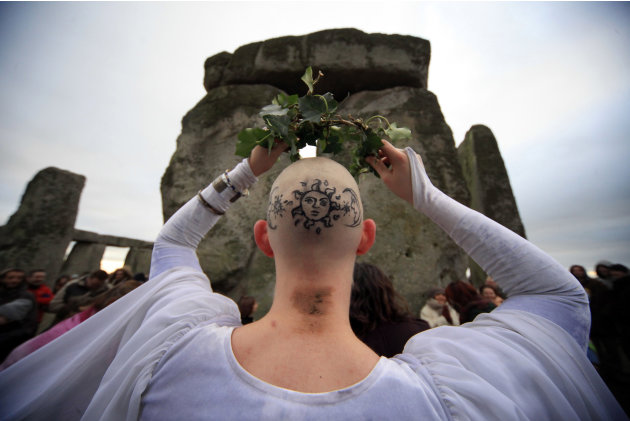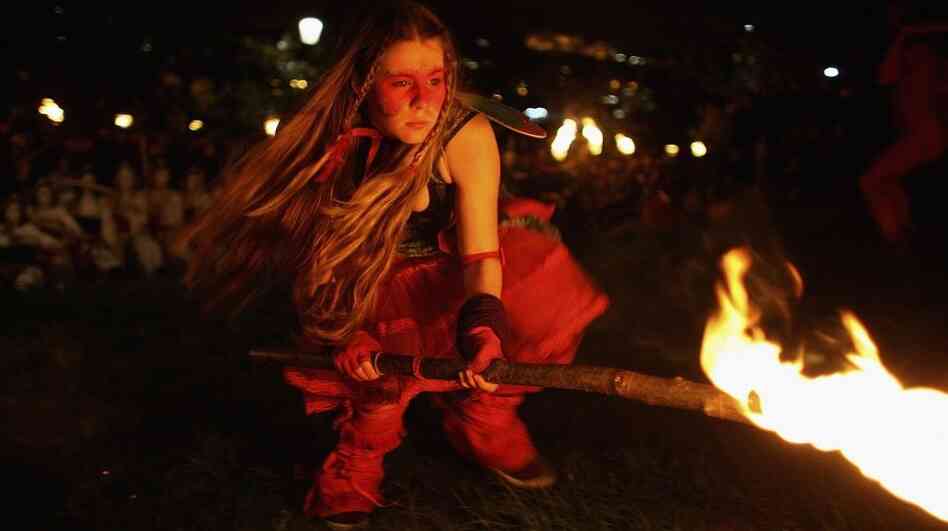The prize for the most bizzare news headline goes to Iceland this week: a group known as the "Asatru religion" is building the first new pagan temple in Iceland in 1,000 years. "High priest" Hilmar Orn Hilmarsson said in an interview with Fox News: "We see this as so much part of our heritage. Some people love the idea, they really want to go back to the Viking era." (1)
The story is that "paganism experienced a revival in Iceland beginning in the 1970s that has paved the way for the new temple." The temple is to be dedicated to Thor, Odin and Frigg: "protector of mankind," "god of wisdom and poetry," and "goddess of domestic and love," respectively. (2)
One naturally wonders whether the members of this religion actually believe in these gods. The answer the worshipers give is a resounding no - the gods are "viewed as mystical and symbolic. Most modern worshipers don't consider them to be living beings that are capable of flying down from the clouds." (3) This may sound a little vague to our ears. Raised in the Judeo-Christian tradition, most of us are used to a god of flesh and blood, a god who became man and ate fish and loaves on the shore of a sea.
Hilmarsson explains: "We don't tend to be literal in our beliefs in Iceland, not even the Christian ones. This is a very gentle movement on how to be a good friend, good to your family and an honorable person." (4)
In light of the vagueness of their beliefs, one also wonders what worshipers will do at this new temple. The worship does not seem to be very organized. "It's more like coming together, sanctifying the movement, having a sacred space," Hilmarsson said. "More close to Hindu ceremonies." (5)
This is an interesting phenomenon.
The headline "Iceland Building First Pagan Temple in 1,000 Years" sounds rather outlandish.
I was incredulous when I first heard about it. In this post, I would like to explore why this scheme sounds so strange to our modern ears.
In his seminal work The Everlasting Man, G.K. Chesterton muses on the nature of ancient mythology. He paints a picture of a young humanity on a search for truth through beauty and creative invention:
The story is that "paganism experienced a revival in Iceland beginning in the 1970s that has paved the way for the new temple." The temple is to be dedicated to Thor, Odin and Frigg: "protector of mankind," "god of wisdom and poetry," and "goddess of domestic and love," respectively. (2)
One naturally wonders whether the members of this religion actually believe in these gods. The answer the worshipers give is a resounding no - the gods are "viewed as mystical and symbolic. Most modern worshipers don't consider them to be living beings that are capable of flying down from the clouds." (3) This may sound a little vague to our ears. Raised in the Judeo-Christian tradition, most of us are used to a god of flesh and blood, a god who became man and ate fish and loaves on the shore of a sea.
Hilmarsson explains: "We don't tend to be literal in our beliefs in Iceland, not even the Christian ones. This is a very gentle movement on how to be a good friend, good to your family and an honorable person." (4)
In light of the vagueness of their beliefs, one also wonders what worshipers will do at this new temple. The worship does not seem to be very organized. "It's more like coming together, sanctifying the movement, having a sacred space," Hilmarsson said. "More close to Hindu ceremonies." (5)
This is an interesting phenomenon.
The headline "Iceland Building First Pagan Temple in 1,000 Years" sounds rather outlandish.
I was incredulous when I first heard about it. In this post, I would like to explore why this scheme sounds so strange to our modern ears.
In his seminal work The Everlasting Man, G.K. Chesterton muses on the nature of ancient mythology. He paints a picture of a young humanity on a search for truth through beauty and creative invention:
This religion [mythology] was not quite a religion. In other words, this religion was not quite a reality. It was the young world’s riot with images and ideas like a young man’s riot with wine or love-making; it was not so much immoral as irresponsible; it had no foresight of the final test of time.(6)
Chesterton claims that there
can be no real return to paganism. Humanity has lost the requisite
innocence. It has lost the mythological mood and primitive fancy that once
allowed paganism to thrive:
[...] the mythology could not have lasted like a theology in any case. Theology is thought, whether we agree with it or not. Mythology was never thought, and nobody could really agree with it or disagree with it. It was a mere mood of glamour and when the mood went it could not be recovered. (7)
What caused this mood to
vanish? Chesterton traces the decline of paganism all the way back to the
industry and organization of the Roman Empire:
[...] the peasant civilization was fading, or had already faded from the whole countryside. The Empire at the end was organised more and more on that servile system which generally goes with the boast of organisation; indeed it was almost as servile as the modern schemes for the organisation of industry. It is proverbial that what would once have been a peasantry became a mere populace of the town dependent for bread and circuses; which may again suggest to some a mob dependent upon doles and cinemas. In this as in many other respects, the modern return to heathenism has been a return not even to the heathen youth but rather to the heathen old age. (8)
How much further we have
come along that road of organization and progress towards industry, since then.
 Society has continued to
turn on the great metal gears of progress, and there is no going back. We
cannot go back to the viking era any more than we can go back to the glory days
of Rome.
Society has continued to
turn on the great metal gears of progress, and there is no going back. We
cannot go back to the viking era any more than we can go back to the glory days
of Rome.
Humankind cannot
honestly return to paganism, just as the tired, disillusioned businessman
cannot return in earnest to his childhood games of cops and robbers. His
childhood is over, and he has lost the ability to believe in his own flights of
fancy. Chesterton traces this stage in the aging process back to the
Enlightenment: “The urban mob became enlightened; that is, it lost the mental
energy that could create myths.” (9)
A definite incredulity
is illustrated by the vagueness of the above-mentioned interview. The Asatru deities are spoken of as "mystical and symbolic. Most modern worshipers don't consider them to be living beings that are capable of flying down from the clouds." (10) This language suggests that these "modern worshipers" would almost be embarrassed to be mistaken for authentic young pagans.
No one seems to take
these “gods” seriously. Thor, Ordin, and Frigg are not the names of revered
beings. Rather they are empty place-holders for "how to be a good friend, good to your family and an honorable person." (11)
Ancient mythology, the
mythology of a young human race, was born of the imagination. The temples and
practices which sprung up around these flights of fancy were solid and human.
But their centerpiece was as whimsical as a day-dream:
But precisely because it began with imagination, there is to the end something of mockery in it, and especially the object of it. [...] All order of the temple is solid and sane and satisfactory to certain parts of our nature; except the very centre of it, which seems strangely mutable and dubious, like a dancing flame. (12)
The ancients certainly
did dance around this dubious flame.
But today, in our
post-enlightenment, post-industrial world, the flame has gone out: “[...] the
spirit of paganism had departed with its familiar spirits. The heart had gone
out of it with its household gods, who went along with the gods of the garden
and the field and the forest.”(13)
 However much we may
admire these mythologies, however much we may long for the young days of
earnest paganism, we cannot go backwards in time. The whimsical flame has gone
out. Now we have only the memory of a flame; and it is around this memory that
the Icelanders are building a shell of a temple.
However much we may
admire these mythologies, however much we may long for the young days of
earnest paganism, we cannot go backwards in time. The whimsical flame has gone
out. Now we have only the memory of a flame; and it is around this memory that
the Icelanders are building a shell of a temple.
-----------------------------------------------------------------------------------------------------------------
Reality fascinates me.
To me, everything real is precious and worth finding out about. That's why I am a student of the phenomenological philosophy to which Dietrich von Hildebrand contributed. Hildebrand practiced what he preached when he said: "Confronted with being, the reverent man remains silent in order to give it an opportunity to speak." (The Art of Living)
I hope to achieve Hildebrand's depth of integrity, both as a philosopher and as a person.
To me, everything real is precious and worth finding out about. That's why I am a student of the phenomenological philosophy to which Dietrich von Hildebrand contributed. Hildebrand practiced what he preached when he said: "Confronted with being, the reverent man remains silent in order to give it an opportunity to speak." (The Art of Living)
I hope to achieve Hildebrand's depth of integrity, both as a philosopher and as a person.
------------------------------------------------------------------------------------------------------------------
(1) Matt Finn, "Iceland Building First Pagan Temple in 1,000 Years," FoxNews.com, Feb 8, 2015, access here.
(2) Finn, First Pagan Temple.
(3) Finn, First Pagan Temple.
(4) Finn, First Pagan Temple.
(5) Finn, First Pagan Temple.
(6) G.K. Chesterton, The Everlasting Man (San Francisco: Ignatius Press, 1993), 158.
(7) Chesterton, 160.
(8) Chesterton, 159-160.
(9) Chesterton, 160.
(10) Finn, First Pagan Temple.
(11) Finn, First Pagan Temple.
Image 4
------------------------------------------------------------------------------------------------------------------




0 comments
Note: Only a member of this blog may post a comment.